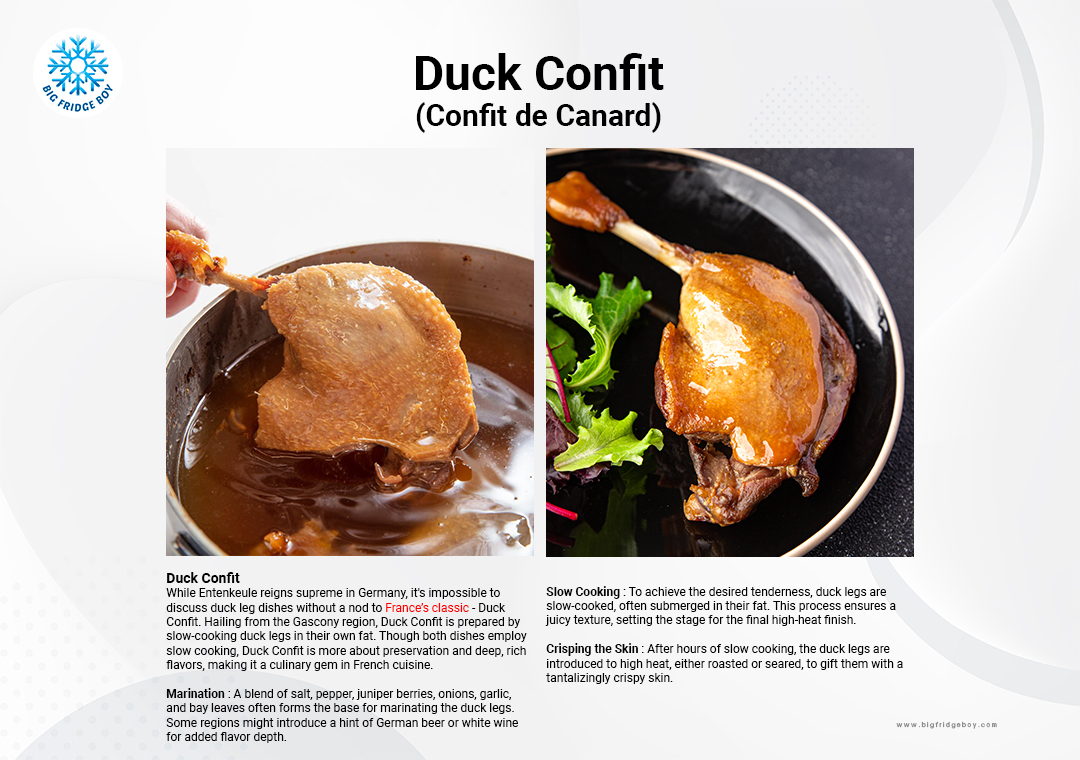"German Entenkeule: A Tale of Tender Duck Legs and Rustic Flavors"
Last updated: 13 Sep 2023 | 1454 Views |

German Duck Leg (Deutsche Entenkeule)
Duck has carved a niche for itself in many world cuisines, and in Germany, it has been celebrated with gusto. The hearty and rustic flavors of German cooking come alive in the Entenkeule, or duck leg. This delectable dish is more than just a meal; it's a culinary journey through Germany's rich history.
Duck, particularly the leg, has been a beloved ingredient in German culinary traditions for centuries. With its sprawling waterways and lakes, Germany naturally became a hub for waterfowl-based dishes. Each region, with its own distinctive flavors and neighboring influences, offers its unique take on duck preparations. Whether it’s the northern coastal regions pairing duck with native fruits or the southern areas near Bavaria enhancing the flavors with beer or wine reductions, the variations are both delightful and numerous.
In traditional German cooking, especially when preparing dishes like Entenkeule (duck leg), the preferred choice is a younger duck, typically between 7 to 8 weeks old. Here are the reasons:
- Tenderness
Younger ducks are more tender, making the meat succulent and easier to cook. Older ducks can be tougher, requiring more extended cooking periods to achieve the desired tenderness. - Flavor
While older ducks can have a more robust flavor, it can sometimes be gamey. Younger ducks offer a more delicate and universally appealing taste. - Size
Younger ducks are smaller, which can be ideal for individual servings, especially when considering dishes like Entenkeule where typically one leg is served per person. - Fat Content
Young ducks have a good balance of meat to fat. This ensures that the duck doesn't dry out during the cooking process, especially during roasting or slow cooking, and gives a deliciously crispy skin.

Duck Confit (Confit de Canard)
While Entenkeule reigns supreme in Germany, it's impossible to discuss duck leg dishes without a nod to France’s classic - Duck Confit. Hailing from the Gascony region, Duck Confit is prepared by slow-cooking duck legs in their own fat. Though both dishes employ slow cooking, Duck Confit is more about preservation and deep, rich flavors, making it a culinary gem in French cuisine.
Preparation and Cooking
- Marination
A blend of salt, pepper, juniper berries, onions, garlic, and bay leaves often forms the base for marinating the duck legs. Some regions might introduce a hint of German beer or white wine for added flavor depth. - Slow Cooking
To achieve the desired tenderness, duck legs are slow-cooked, often submerged in their fat. This process ensures a juicy texture, setting the stage for the final high-heat finish. - Crisping the Skin
After hours of slow cooking, the duck legs are introduced to high heat, either roasted or seared, to gift them with a tantalizingly crispy skin.
Storing Duck Legs
Regardless of whether you're indulging in the German Duck Leg or the French Duck Confit, proper storage is essential:
- Refrigeration
If you're cooking them within a couple of days, place the duck legs in the refrigerator's coldest part, ideally in their original packaging or a shallow covered container. - Freezing
For longer storage, wrap the legs securely and freeze. Labeling with a date helps track freshness. They can be stored frozen for up to 6 months. - Thawing
Best thawed in the refrigerator. If short on time, a cold water method can be employed, but ensure immediate cooking thereafter. - Leftovers
Cooked leftovers should be consumed within 3-4 days when stored in the refrigerator.
By maintaining proper storage techniques, the freshness and flavors of the duck are preserved, ensuring a delicious meal every time.





